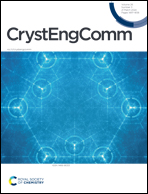Crystal structures and stimuli-responsive properties for three novel D–A type salicylhydrazide–viologen compounds with free radical properties under ambient conditions†
Abstract
Viologen is capable of generating radicals in response to an applied stimulus, giving it an abundance of stimuli responsive properties. However, the radical state of viologen is often unstable, which hinders further studies on the radical properties of viologen. In this paper, the salicylhydrazide group was chosen as a donor group to bond with mono-substituted bipyridyl groups to obtain three novel D–A type viologen compounds. The compounds were harvested and characterized by X-ray single crystal diffraction, optical spectroscopy, EPR and DFT calculation, etc. The results show that compounds 1–3 adopt certain free radical states at room temperature under ambient light, which may be attributed to the electron-donating properties of the salicylhydrazide group and the degree of system conjugation. In addition, compound 1 has a hydrochromic property and compounds 2 and 3 have photocurrent effects under UV radiation.



 Please wait while we load your content...
Please wait while we load your content...